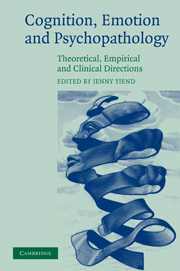Book contents
- Frontmatter
- Contents
- List of contributors
- An introduction and synthesis
- Andrew Mathews: a brief history of a clinical scientist
- Part I Theoretical approaches
- Part II Empirical directions
- Part III Clinical perspectives
- 10 Maintenance mechanisms in social anxiety: an integration of cognitive biases and emotional processing theory
- 11 Mental imagery and social phobia
- 12 Experimental cognitive psychology and clinical practice: autobiographical memory as a paradigm case
- 13 Mindfulness-based cognitive therapy
- 14 Clinical difficulties to revisit
- Index
10 - Maintenance mechanisms in social anxiety: an integration of cognitive biases and emotional processing theory
Published online by Cambridge University Press: 23 November 2009
- Frontmatter
- Contents
- List of contributors
- An introduction and synthesis
- Andrew Mathews: a brief history of a clinical scientist
- Part I Theoretical approaches
- Part II Empirical directions
- Part III Clinical perspectives
- 10 Maintenance mechanisms in social anxiety: an integration of cognitive biases and emotional processing theory
- 11 Mental imagery and social phobia
- 12 Experimental cognitive psychology and clinical practice: autobiographical memory as a paradigm case
- 13 Mindfulness-based cognitive therapy
- 14 Clinical difficulties to revisit
- Index
Summary
We feel honoured to contribute this chapter to a volume that is devoted to recognizing the unique place that Andrew Mathews has had in the study of anxiety and the anxiety disorders. From the beginning of his career, he set the course for research on anxiety, including psychophysiology, treatment and, most recently, cognitive mechanisms. This chapter will relate predominantly to Mathews' contribution to the cognitive psychopathology of anxiety (see Chapter 1 in this book), attempting to integrate Mathews and Mackintosh's (1998) concepts of anxiety with Foa and Kozak's (1985, 1986; see also Foa & McNally, 1996; Foa & Cahill, 2001) emotional processing theory to further our understanding of social anxiety disorder and its treatment.
Emotional processing theory
Emotional processing theory utilizes information processing concepts to explain the psychopathology and treatment of anxiety disorders. A basic concept in emotional processing theory is the presence of fear structures that serve as blueprints for responding to danger (Foa & Kozak, 1986; Lang, 1977). The theory proposes that three kinds of representations are contained in these structures:
Information about the stimuli,
Information about verbal, physiological and behavioural responses, and
The interpretive meaning of these stimuli and responses.
Thus, a fear structure is comprised of an intricate network of associations of the different elements. A normal fear structure contains associations that generally reflect reality accurately (e.g. a car veering towards me → fear (heart rate acceleration, scanning the road, veering my car off the road) → cars coming towards me are dangerous).
- Type
- Chapter
- Information
- Cognition, Emotion and PsychopathologyTheoretical, Empirical and Clinical Directions, pp. 213 - 231Publisher: Cambridge University PressPrint publication year: 2004
- 3
- Cited by

